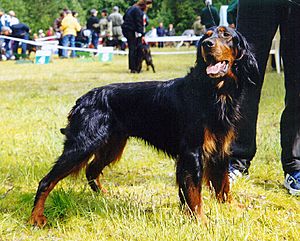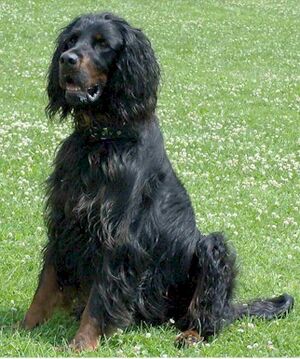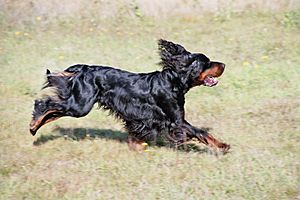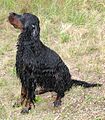Gordon Setter facts for kids

A Gordon Setter
|
|||||||||||||||||||||||||
| Origin | Scotland | ||||||||||||||||||||||||
|---|---|---|---|---|---|---|---|---|---|---|---|---|---|---|---|---|---|---|---|---|---|---|---|---|---|
|
|||||||||||||||||||||||||
|
|||||||||||||||||||||||||
| Domestic dog (Canis lupus familiaris) | |||||||||||||||||||||||||
The Gordon Setter is a large dog breed. It belongs to the setter family, which also includes the Irish Setter and English Setter. Setters are known as "Sporting" or "Gundog" breeds. This means they were originally bred to help hunters find and point out birds.
Gordon Setters were used to hunt different kinds of game birds. In the United Kingdom, they would find birds like partridge, grouse, or pheasant. In other parts of the world, they might hunt quail or guineafowl. These dogs are special because they can find a bird and then "point" at it. This means they stand very still, showing the hunter where the bird is hiding. The bird often stays hidden, hoping not to be seen. This teamwork makes hunting with these dogs possible.
Contents
What Does a Gordon Setter Look Like?
Appearance of Gordon Setters
Gordon Setters are often called "black and tans." They have a shiny, coal-black coat. They also have special markings that are a rich reddish-brown color. You can see these markings on their paws, lower legs, chest, throat, and muzzle. They also have a small spot of this color above each eye. Sometimes, a tiny bit of white is allowed on their chest.
Even though it's rare, some Gordon Setters are born with a red coat. This happens because of a special gene. However, dogs that are mostly tan, red, or buff (a light yellowish-brown) cannot be shown in dog shows. A Gordon's coat should be straight or slightly wavy, never curly. It is long and silky, with longer hair (called "feathering") on their chest, stomach, ears, legs, and tail. These dogs look smart, noble, and graceful. They are the heaviest of the setter breeds. Male Gordons can be up to 27 inches (69 cm) tall and weigh up to 80 pounds (36 kg).
Gordon Setter Temperament
Gordon Setters are alert, interested, and confident dogs. They are brave, smart, and very capable. They are also very loyal and loving towards their owners. These dogs do best in a home where they get lots of attention and love. They make good family pets.
Young Gordon Setters and puppies can be very playful and energetic. They are patient, but they might not be the best choice for homes with very young children. Gordons are sensitive and understanding. They love to learn and need training that is firm but gentle. It's important to start training and helping them meet new people and places (socialization) early. This breed takes a long time to grow up, often not reaching their full maturity until they are three years old or more. They can act like puppies even when they are older.
Gordon Setters were bred to run and need a lot of exercise. They need about 60 to 80 minutes of strong exercise every day. Young dogs should not exercise too much or start intense activities like dog agility until they are at least 18 months old. This helps prevent joint problems later on. Because they have strong hunting instincts, Gordons should not be left to roam freely without supervision. They might follow an interesting scent and wander into dangerous places like busy roads.
Gordon Setter Health
Gordon Setters are generally healthy dogs. However, like many large breeds, they can sometimes get hip dysplasia. This is a condition where the hip joint doesn't form correctly. Other health issues can include hypothyroidism (a thyroid problem), gastric torsion (also known as bloat, a serious stomach condition), and eye problems. Eye issues can include progressive retinal atrophy (PRA) and cataracts. Gordon Setters usually live for about 10 to 12 years.
In 2009, a report came out about a type of PRA that appears later in a Gordon Setter's life. In 2011, a DNA test became available for this condition. It's called rcd4. This test helps identify dogs that carry the gene for this eye disease. It's thought that up to half of all Gordon Setters might carry this gene.
Where Do Gordon Setters Come From?
The Gordon Setter's history goes back a long way. Many experts believe that setters, including the Gordon Setter, came from an older type of dog called the "Land Spaniel." These spaniels were trained to "set" or "couch" (lie down) when they found birds. This helped hunters catch birds with nets.
Some people also think that other dog breeds, like hounds or pointers, might have been mixed in to help develop the setter. For example, one writer in the early 1800s suggested that setters came from mixing a Spanish pointer with a large English spaniel.
The modern Gordon Setter is mostly black with rich tan markings. They are a bit bigger and heavier than the Irish or English Setters. They share a common background with these other setters. The name "Gordon Setter" was officially given to the breed in 1924 by The Kennel Club. Before that, they were simply known as "black and tan setters."
These dogs were found in many kennels, not just those belonging to Alexander Gordon, 4th Duke of Gordon. In fact, many of the setters at the Duke's castle were actually tri-colored (three colors), not just black and tan.
The Gordon Setter breed first came to the United States in 1842. Two men, George Blunt and Daniel Webster, bought two dogs named Rake and Rachel from the Duke's kennels. The American Kennel Club officially recognized the breed in 1892.
Images for kids
See also
 In Spanish: Gordon setter para niños
In Spanish: Gordon setter para niños










